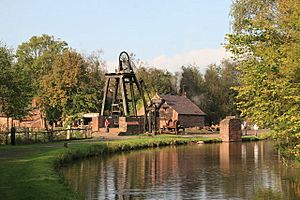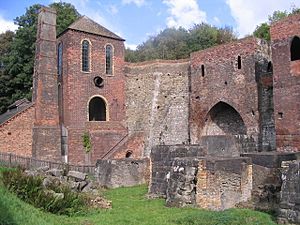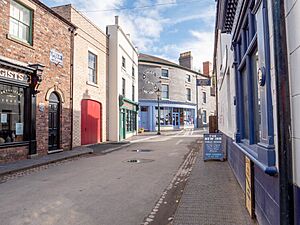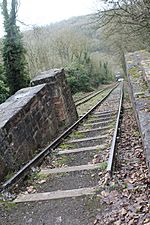Blists Hill Victorian Town facts for kids
Blists Hill Victorian Town is a special place in Madeley, Shropshire, England. It's like stepping back in time to a Victorian town from the late 1800s and early 1900s. This amazing open-air museum lets you experience what life was like back then.
The museum is built on an old industrial site. It used to have brick factories, blast furnaces, and mines. Blists Hill opened in 1973 and has grown a lot since then. It's one of ten museums run by the Ironbridge Gorge Museum Trust.
The museum has three main areas. There's a town with Victorian shops like a bank and a bakery. An industrial area shows how people worked in factories. There's also a countryside area with old cottages and a church. Many TV shows and films, like Doctor Who, have used Blists Hill as a filming spot.
Contents
History of Blists Hill

In the 1700s and 1800s, Blists Hill was a busy industrial area. Companies like the Madeley Wood Company ran brick and tile factories. They also had blast furnaces and mines for coal, iron, and fire clay.
A small part of the Shropshire Canal ran through the site. This canal connected to the Hay Inclined Plane. This special lift moved boats up and down a 207 ft (63 m) tall slope. It helped transport goods from Blists Hill to Coalport.
Exploring the Open-Air Museum
What is Blists Hill Museum?
Blists Hill Victorian Town first opened in 1973. It was originally called Blists Hill Open Air Museum. The museum has been adding new things ever since. Its buildings fit into three groups. Some buildings were already part of the old industrial site, like the brickworks. Others are copies of typical Victorian buildings, like the sweet shop. Finally, some original buildings were moved here from other places. For example, The New Inn public house came from Walsall.
Meeting Victorian Characters
Each building at Blists Hill has people dressed in Victorian clothes. These "demonstrators" are experts in the skills and history of their jobs. For instance, in the print shop, you can watch them print posters. They talk about the Victorians as "they" or "them." This helps visitors compare old ways with modern life. You might also see staff operating old steam engines or looking after pigs.
Using Old Money
When you first arrive, you can visit the bank. It looks like an old Lloyds Bank branch. Here, you can swap your modern money for special token coins. These tokens look like old pennies, halfpennies, and sixpences. You can use these tokens to buy things in the museum's shops. The gift shop at the entrance only takes modern money.
The Victorian Town Area
The High Street in the Upper Town has many interesting shops. You can find a chemist (pharmacy), a butcher, and a grocer. There's also a printer where you can see old printing presses.
Small craft workshops are also in this area. These include an iron foundry, a shoeing smith (who makes horseshoes), a bootmaker, and a locksmith. You can also see a decorative plasterer and a builder.
In Quarry Bank, you'll find a tallow candle factory. There's also a bakery and a doctor's office. A Board School from Stirchley shows what classrooms were like.
Recently, a new area called 'Canal Street' was built. It looks just like old buildings from the Telford area. Here, you can find a fish and chip shop, a fabric shop, and a post office. There's also a bigger sweet shop.
At the end of Canal Street, a walkway leads to the old brick and tile works ruins. On certain days, a working copy of a Richard Trevithick steam locomotive runs on a short track. This original locomotive was the world's first steam engine on rails! A special shed was built in 2015 to keep the locomotive safe.
The Ironworks Area

The Madeley Wood Company's blast furnaces made pig iron from 1832 to 1911. Their old remains are still there. A large blowing engine from another ironworks was placed in one of the old buildings. Nearby, you can see two large beam engines. There's also a wrought iron factory with old equipment.
The Countryside Area
The quieter parts of Blists Hill show how nature reclaims old industrial land. Here, you can see a corrugated iron church, called St Chad's Mission Church. There's also a squatter cottage from Dawley. A toll house, designed by Telford, is also in this area. Toll houses were where people paid to use roads.
New Additions to the Museum
In 2009, Blists Hill finished a big improvement project. This included the new buildings on Canal Street. A new World Heritage Visitor Centre was also built. They added a narrow gauge Mine Railway, which looks like a 1920s clay mine. There's also an Inclined Lift to help visitors with limited movement reach the lower parts of the site.
The Hay Inclined Plane
The Hay Inclined Plane is a special canal inclined plane. It's 207 ft (63 m) high. It was part of the Shropshire Canal and connected the industrial area of Blists Hill to the River Severn. This inclined plane worked from 1792 to 1894.
It used two railway tracks to move box-shaped boats, 20 ft (6.1 m) long, up and down the slope. An empty boat would go down to the river, while a full boat was pulled up to the canal. A rope connected the two boats. The weight of the full boat going down helped pull the empty boat up. At the bottom, the rails went underwater so the boats could float away. You can visit this historic site as part of Blists Hill Victorian Town.
Blists Hill as a Filming Location
Blists Hill has been a popular place for filming TV shows and movies. In 1979, the children's TV show Blue Peter filmed a segment there. Later, in 1985, the TV series Doctor Who used it as a main filming spot for an episode called The Mark of the Rani.
The 1995 film Feast of July was also shot at Blists Hill. In September 2009, an episode of Antiques Roadshow was filmed there. In 2010, a historical documentary called Victorian Pharmacy used Blists Hill to show what a pharmacy was like in the 1800s.
See also
- Beamish Museum
- Living museum
- Avoncroft Museum
- Black Country Living Museum





